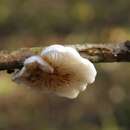Associations
provided by BioImages, the virtual fieldguide, UK
In Great Britain and/or Ireland:
Foodplant / saprobe
fruitbody of Crepidotus variabilis is saprobic on dead, attached twig of Broadleaved trees
Animal / dung saprobe
fruitbody of Crepidotus variabilis is saprobic in/on dung or excretions of old, weathered dung of Herbivores
Remarks: Other: uncertain
Comprehensive Description
provided by North American Flora
Claudopus multiformis Murrill
Agaricus variabilis Pers. Obs. Myc. 2: 46. 1799. Not A. variabilis Batsch, 1783. Claudopus variabilis Gill. Champ. Fr. 426. 1876.
Pileus fleshy, resupinate to reflexed, 1-2.5 cm. broad; surface white, smooth, tomentose; lamellae distant, broad, white to red; spores ellipsoid, pale-red, 6-7 X 2.5-4 m; stipe eccentric or wanting, short, incurved, villose.
Type locality: Europe.
Habitat: On decayed wood, usually spruce.
Distribution: Massachusetts and North Carolina; also in Europe.
- bibliographic citation
- William Alphonso Murrill. 1917. (AGARICALES); AGARICACEAE (pars); AGARICEAE (pars). North American flora. vol 10(2). New York Botanical Garden, New York, NY
Crepidotus variabilis: Brief Summary
provided by wikipedia EN
Crepidotus variabilis is a species of saprophytic fungi in the family Crepidotaceae. It is commonly known as a variable oysterling in the United Kingdom and is seen there in autumn. May occur solitary, but more often in small scattered groups from summer to autumn on twigs and other woody debris of broad-leaved trees. Very common but often confused with Crepidotus cesatii.
- license
- cc-by-sa-3.0
- copyright
- Wikipedia authors and editors

